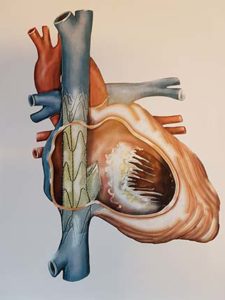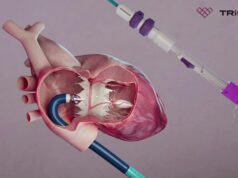
In this commentary for Cardiovascular News, Stefan Toggweiler writes about how the Tricento device could address the current need in the management of tricuspid regurgitation and more.
Tricuspid regurgitation is a common valvular heart disease that has been directly related to higher morbidity and mortality rates.1 When tricuspid regurgitation is severe, the pressure in the right atrium and the caval veins rises and backflow during systole, the so-called “v wave”, occurs. In this situation, congestion leads to oedema, ascites and finally impaired function of the organs including the liver and the kidneys.
Affected patients may remain asymptomatic for a long time. Over time, right ventricular function may decrease and patients become symptomatic. However, operative risk in such patients is high and outcomes may be suboptimal. Therefore, there is a consensus in the community that patients should be identified and treated earlier to improve outcomes and decrease operative risk. Also that low-risk procedures may be a very attractive alternative to surgical treatment in such high-risk, often polymorbid patients.
Following the success of percutaneous treatment of aortic and mitral valve disease, a number of devices have now been developed aiming to repair the tricuspid annulus which has led to mixed outcomes. The tricuspid valve poses many challenges such as complex variable anatomy, often severely dilated annuli and associated poor right-ventricular function. Therefore, alternative catheter-based concepts such as (bi)caval valve implantation (CAVI) have been utilised and may offer new perspectives in this field.2 CAVI aims to reduce backflow into the caval veins and treat associated congestions of the organs and symptoms of heart failure.
The concept of the Tricento transcatheter heart valve
 The Tricento transcatheter heart valve aims to abolish backflow in the venous system to alleviate symptoms associated with tricuspid regurgitation without touching the native tricuspid valve. It consists of a bicaval anchored covered stent with a lateral bicuspid valve element made of thin porcine pericardium leaflets with a low closing pressure.
The Tricento transcatheter heart valve aims to abolish backflow in the venous system to alleviate symptoms associated with tricuspid regurgitation without touching the native tricuspid valve. It consists of a bicaval anchored covered stent with a lateral bicuspid valve element made of thin porcine pericardium leaflets with a low closing pressure.
The Tricento valve also aims to abolish the systolic backflow in both the inferior and superior caval veins, addressing the regurgitation of both caval veins with one single implant. The valve is delivered through a 24F delivery system via transfemoral access. Implantation is performed top-down without the need for rapid pacing. The device is fully repositionable and retreivable up to its final release. To account for the marked inter-patient anatomical variability, the stent length and diameter in the current iteration must be custom made.
Following the successful first-in-human implantation, which was performed at our institution in Lucerne hospital, Switzerland, six more implants have been performed.3 From this preliminary experience, it can be stated that the procedure is safe and straight forward. The valve was implanted at the target position in all cases. A marked reduction of the v-wave in the caval vein was documented, potentially translating into improved organ perfusion. Indeed, improvements in kidney function, liver function, appetite and functional status was documented following these implants.
Since the lateral valve element faces towards the interatrial septum, a transseptal puncture for a left-sided procedure is still possible (e.g. MitraClip, Abbott). Since the native tricuspid valve is not touched, the Tricento valve does not preclude later surgical treatment or additional percutaneous therapies.
The future
Efficacy regarding long-term haemodynamic and clinical outcomes has yet to be proven in prospective studies including a larger number of patients. The concerns associated with CAVI include the ventricularisation of the right atrial pressure as well as the persistence of atrial and ventricular volume overload, potentially promoting right-ventricular failure and atrial fibrillation. However, in the present limited human experience no such effects were observed.
The question also remains if this procedure can be performed in patients with a pre-existing pacemaker. There are a few concerns with this as there is a possibility of lead migration, a higher risk for an endoleak and the unknown risk of long-term insulation defects of the leads.
Conclusion
The Tricento valve may reflect a promising and safe therapeutic alternative in order to improve heart-failure related symptoms and quality of life for patients with severe tricuspid regurgitation who are not considered suitable to undergo open heart surgery.
Stefan Toggweiler is the Co-Chief Physician of cardiology and Head of Interventional cardiology at Lucerne Hospital in Switzerland.
References
- Nath et al. J Am Coll Cardiol 2004; 43(3): 405–09.
- Lauten et al. Eur Heart J 2014; 35: 1651.
- Toggweiler et al. EuroIntervention 2018; 14(7): 758–61.













